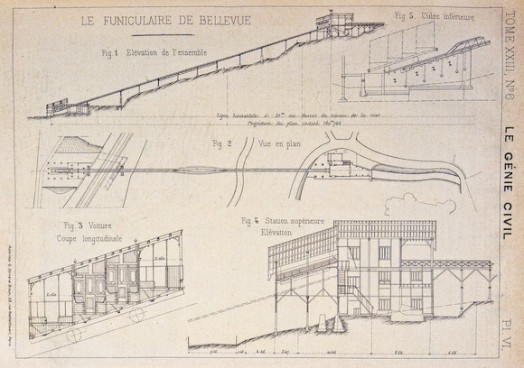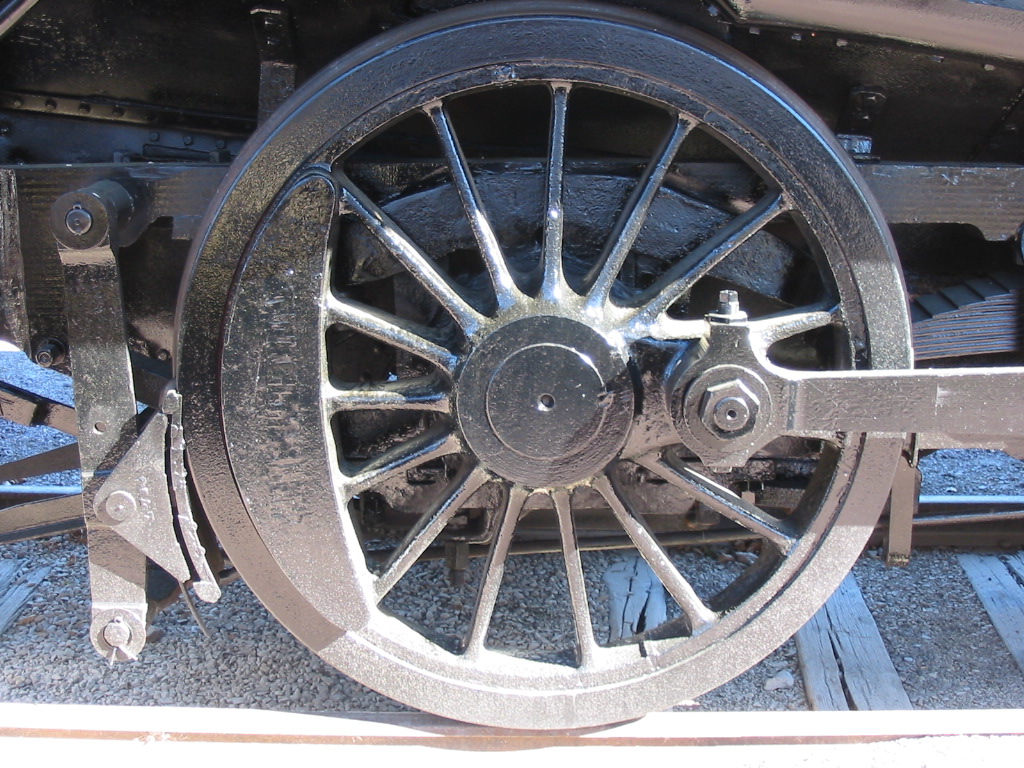|
Bellevue Funicular
The Bellevue funicular (french: funiculaire de Bellevue), in Meudon, Hauts-de-Seine department, was from 1893 to 1934 a funicular running from the Bellevue-Funiculaire station on the Coteaux line (today, ''Brimborion''), to the Gare de Bellevue, on the Paris–Brest railway line. Description The line, designed by the engineers Guyenet, Madamet and Tinel, was of single track rising . After being permitted to cross the Coteaux line, the lower station was raised to connect with the route from Vaugirard (Bas Meudon), thus requiring passengers to climb a staircase, clearly seen on the left of the station. With a constant gradient of 16° 56' (about 30%), it was entirely built on a viaduct of twelve metal sections, resting on five lattice pillars and two masonry abutments with a foundation of solid brick. A passing loop was provided in the middle of the route. The Vignole rails weighed , at a track gauge of . Safety brakes were provided by a rack rail. Traction was p ... [...More Info...] [...Related Items...] OR: [Wikipedia] [Google] [Baidu] |
Counterbalance
A counterweight is a weight that, by applying an opposite force, provides balance and stability of a mechanical system. The purpose of a counterweight is to make lifting the load faster and more efficient, which saves energy and causes less wear and tear on the lifting machine. Counterweights are often used in traction lifts (elevators), cranes and funfair rides. In these applications, the expected load multiplied by the distance that load will be spaced from the central support (called the "tipping point") must be equal to the counterweight's mass times its distance from the tipping point in order to prevent over-balancing either side. This distance times mass is called the load moment. A counterbalance is a weight or force that balances or offsets another as when two objects of equal weight, power, or influence are acting in opposition to each other. The objects are then said to be in counterbalance. Counterweights in action Trebuchet: There are five major components of a ... [...More Info...] [...Related Items...] OR: [Wikipedia] [Google] [Baidu] |
Meudon Bellevue
Meudon () is a municipality in the southwestern suburbs of Paris, France. It is in the département of Hauts-de-Seine. It is located from the center of Paris. The city is known for many historic monuments and some extraordinary trees. One of them, the Imperial Cedar (), attracted the attention of Empress Eugénie and Queen Victoria. As of March 2021, the tree is in good condition, but it is threatened by real estate speculation. Another real estate project is planned for the historic park of the Napoleon III villa built by Charles Schacher. Both projects are controversial and have aroused local opposition. Geography The town of Meudon is built on the hills and valleys of the Seine. The wood of Meudon lies for the most part to the west of the town. The north-west part of Meudon, overlooking the Seine, is known as ''Bellevue'' ("beautiful view"). History At Meudon, the argile plastique clay was extensively mined in the 19th century. The first fossil of the European diatryma ' ... [...More Info...] [...Related Items...] OR: [Wikipedia] [Google] [Baidu] |
Second World War
World War II or the Second World War, often abbreviated as WWII or WW2, was a world war that lasted from 1939 to 1945. It involved the vast majority of the world's countries—including all of the great powers—forming two opposing military alliances: the Allies and the Axis powers. World War II was a total war that directly involved more than 100 million personnel from more than 30 countries. The major participants in the war threw their entire economic, industrial, and scientific capabilities behind the war effort, blurring the distinction between civilian and military resources. Aircraft played a major role in the conflict, enabling the strategic bombing of population centres and deploying the only two nuclear weapons ever used in war. World War II was by far the deadliest conflict in human history; it resulted in 70 to 85 million fatalities, mostly among civilians. Tens of millions died due to genocides (including the Holocaust), starvation, ma ... [...More Info...] [...Related Items...] OR: [Wikipedia] [Google] [Baidu] |
Rail Adhesion
An adhesion railway relies on adhesion traction to move the train. Adhesion traction is the friction between the drive wheels and the steel rail. The term "adhesion railway" is used only when it is necessary to distinguish adhesion railways from railways moved by other means, such as by a stationary engine pulling on a cable attached to the cars or by railways that are moved by a pinion meshing with a rack. The friction between the wheels and rails occurs in the wheel-rail interface or contact patch. The traction force, the braking forces and the centering forces, all contribute to stable running. However, running friction increases costs by requiring higher fuel consumption and by increasing the maintenance needed to address fatigue (material) damage, wear on rail heads and on the wheel rims and rail movement from traction and braking forces. Variation of friction coefficient Traction or friction is reduced when the top of the rail is wet or frosty or contaminated with grea ... [...More Info...] [...Related Items...] OR: [Wikipedia] [Google] [Baidu] |
First World War
World War I (28 July 1914 11 November 1918), often abbreviated as WWI, was one of the deadliest global conflicts in history. Belligerents included much of Europe, the Russian Empire, the United States, and the Ottoman Empire, with fighting occurring throughout Europe, the Middle East, Africa, the Pacific, and parts of Asia. An estimated 9 million soldiers were killed in combat, plus another 23 million wounded, while 5 million civilians died as a result of military action, hunger, and disease. Millions more died in genocides within the Ottoman Empire and in the 1918 influenza pandemic, which was exacerbated by the movement of combatants during the war. Prior to 1914, the European great powers were divided between the Triple Entente (comprising France, Russia, and Britain) and the Triple Alliance (containing Germany, Austria-Hungary, and Italy). Tensions in the Balkans came to a head on 28 June 1914, following the assassination of Archduke Franz Ferdina ... [...More Info...] [...Related Items...] OR: [Wikipedia] [Google] [Baidu] |
Mobilization
Mobilization is the act of assembling and readying military troops and supplies for war. The word ''mobilization'' was first used in a military context in the 1850s to describe the preparation of the Prussian Army. Mobilization theories and tactics have continuously changed since then. The opposite of mobilization is demobilization. Mobilization became an issue with the introduction of conscription, and the introduction of the railways in the 19th century. Mobilization institutionalized the mass levy of conscripts that was first introduced during the French Revolution. A number of technological and societal changes promoted the move towards a more organized way of deployment. These included the telegraph to provide rapid communication, the railways to provide rapid movement and concentration of troops, and conscription to provide a trained reserve of soldiers in case of war. History Roman Republic The Roman Republic was able to mobilize at various times between 6% (81–8 ... [...More Info...] [...Related Items...] OR: [Wikipedia] [Google] [Baidu] |
Bicycle
A bicycle, also called a pedal cycle, bike or cycle, is a human-powered or motor-powered assisted, pedal-driven, single-track vehicle, having two wheels attached to a frame, one behind the other. A is called a cyclist, or bicyclist. Bicycles were introduced in the 19th century in Europe. By the early 21st century, more than 1 billion were in existence. These numbers far exceed the number of cars, both in total and ranked by the number of individual models produced. They are the principal means of transportation in many regions. They also provide a popular form of recreation, and have been adapted for use as children's toys, general fitness, military and police applications, courier services, bicycle racing, and bicycle stunts. The basic shape and configuration of a typical upright or "safety bicycle", has changed little since the first chain-driven model was developed around 1885. However, many details have been improved, especially since the advent of modern ... [...More Info...] [...Related Items...] OR: [Wikipedia] [Google] [Baidu] |
Centime
Centime (from la, centesimus) is French for " cent", and is used in English as the name of the fraction currency in several Francophone countries (including Switzerland, Algeria, Belgium, Morocco and France). In France, the usage of ''centime'' goes back to the introduction of the decimal monetary system under Napoleon. This system aimed at replacing non-decimal fractions of older coins. A five-centime coin was known as a ''sou'', i.e. a solidus or shilling. In Francophone Canada of a Canadian dollar is officially known as a ''cent'' (pronounced /sɛnt/) in both English and French. However, in practice, the form of ''cenne'' (pronounced /sɛn/) has completely replaced the official ''cent''. Spoken and written use of the official form ''cent'' in Francophone Canada is exceptionally uncommon. In the Canadian French vernacular ''sou'', ''sou noir'' (' means "black" in French), ''cenne'', and ''cenne noire'' are all widely known, used, and accepted monikers when referring to e ... [...More Info...] [...Related Items...] OR: [Wikipedia] [Google] [Baidu] |
Voguéo
Voguéo was a water taxi service operated on the rivers Seine and the Marne in the Île-de-France (the area around Paris). The Syndicat des transports d'Île-de-France (STIF) adopted the service in 2007. It started on 28 June 2008 between the Gare d'Austerlitz in the 13th arrondissement of Paris and the École Vétérinaire de Maisons-Alfort Métro station. Between the two termini the journey took 38 minutes, and the following year this was reduced to 28. Unlike the tourist river services in Paris (such as the '' bateaux-mouches''), this new route was different. It was designed for commuters, not tourists, and financed by the STIF, which meant it could be integrated into the existing fare system for the Île-de-France (see the section on fares and financing, below). For the occasional traveller, a one-time ticket was sold on board (the "Ticket "T+"" was not accepted). The route revived passenger river transport on the Seine, since it disappeared in 1934 from competition w ... [...More Info...] [...Related Items...] OR: [Wikipedia] [Google] [Baidu] |






.jpg)